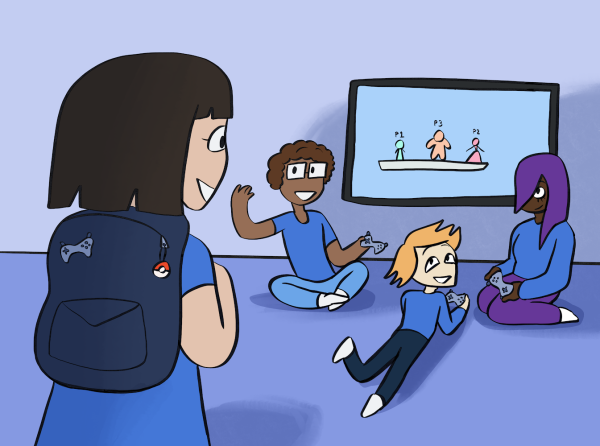OPINION: Asynchronous classes are not worth full tuition
Prior to the Covid-19 pandemic, the majority of online classes at DePaul were offered asynchronously.
“22 percent of classes offered at DePaul prior to the pandemic were online, and predominantly asynchronous,” said DePaul’s Director of Online Learning Joann Martyn via email.
Many students who would not choose to participate in an online class were now made to choose either synchronous, asynchronous, or hybrid classes in order to complete their degrees.
While many students and faculty are enjoying the opportunity to safely quarantine and get an education, other students, myself included, feel as though online classes—particularly asynchronous classes— are not providing them an educational experience worthy of a normal tuition price.
“Asynchronous learning allows students to view instructional materials each week at any time they choose and does not include a live video lecture component,” writes Julia Schreider for the Ohio State University’s official website. “The main difference between asynchronous learning and synchronous learning is this live instruction component occurring at a set time.”
It is no argument that online classes are extremely different from in-person classes. The ability to connect with classmates, professors and academic resources has undergone a significant shift.
Yes, asynchronous classes are very straightforward and allow students to choose the times in which they work on class material, but are seriously lacking in terms of human connection and valuable discussion that an in-person or synchronous class provides.
Because asynchronous classes do not offer the range of experiences and discussions that synchronous classes do, they should be provided at a lower cost to students.
“A student’s ability to succeed in an asynchronous class depends on a few factors,” said Jason Martin, a journalism professor at DePaul. Martin has taught several asynchronous classes prior to the pandemic. He is planning on teaching an asynchronous class in both the December intersession and winter 2021.
Martin added that although asynchronous classes can limit a student’s ability to connect with their classmates and instructor, there are several positives in terms of flexibility and pacing. Martin thinks asynchronous classes offer out-of-state students, international students and working students the freedom to optimize their schedules.
While the freedoms that asynchronous classes offer are enticing, the lack of communication with an instructor or classmate still makes me feel like I’m only receiving half the experience.
Aneesah Shealey, a junior at DePaul majoring in African Black Diaspora studies, feels that asynchronous classes are not providing her with a sticker-price education and feels cheated out of a quality education through asynchronous classes.
“[School] feels like it’s harder to manage now for some reason. I’m doing the same course load that I’m used to, but asynchronous classes are killing my love of learning,” Shealey said.
Shealey, who is taking an asynchronous class about race in media, has been struggling to connect with her professor and fellow classmates. Much of the material that Shealey engages with is of a heavy subject matter — racism, lynchings and overall Black suffering.
Although it is work that she loves, she also feels that the course does not offer enough mental health support for the students or opportunities for peer discussion.
Shealey and I are not the only students who are becoming drained from asynchronous classes.
“I haven’t talked to one person who hasn’t strongly considered taking the next two quarters off,” said Kelly Phlean, a junior majoring in communications and media.
Phelan is currently taking two asynchronous classes. One of them is a two-credit elective, while the other is a class for her major.
“At first, I was looking forward to the asynchronous classes, because I could work at my own pace and on my own schedule,” Phelan said “Now that the quarter is almost over, I think I kind of hate them.”
When asked if Phelan feels like she should be paying the normal tuition of roughly $40,000 a year, Phelan quickly differed.
“Definitely not,” she said,
According to a Forbes article, only four percent of universities lowered their tuition costs this autumn. 34 percent of universities kept their tuition costs the same. 62 percent decided to increase their tuition costs, although the majority of classes are only offered online.
Although asynchronous classes do offer students the freedom to work at their own paces, the lack of connection with instructors and fellow classmates feels isolating.
Connecting with classmates in asynchronous classes has been particularly challenging, as it is hard to get to know someone whose face you never see. In the past two quarters, I have found it very difficult to retain information from my asynchronous classes. It barely feels like I took a class at all.
Moreover, the way that asynchronous classes operate can make students feel as if they are teaching themselves. It makes one wonder: what exactly are students paying such high tuition rates for, especially in the midst of a pandemic?
One of the most valuable aspects of college has been the connections fostered through classes. Although it is still difficult to create these connections through a synchronous class that meets through Zoom once or twice a week, it is far easier to do so in those settings rather than asynchronously.
Asynchronous classes may be more convenient, but they certainly do not feel like the kind of classes that should be offered at full price.

















Rebecca Budds • Nov 9, 2020 at 12:20 pm
Thank you for writing this! I’m in 4 asynchronous classes and it sucks. I also didn”t have a choice as there weren’t any other options. My profs are literally using their summer class material. I also have no interactions with any students. The only time I interact with my prof is if I have a question. Really wish DePaul would hear students out about this.